Hamsters are popular pets, and so it isn’t surprising to find baby hamsters available from breeders and hamster owners. They’re relatively easy to care for, cuddly, and adorable. But there are important facts to know about the development of baby hamsters and how to raise them to be happy, healthy adults.
Are you a proud new owner of baby Dwarf hamsters? Thinking about contacting a breeder to adopt a baby Syrian hamster? Whatever the case, you’re on the right page!
In this article, we’ll explore how to take care of baby hamsters and their development from the day they’re born to the day that you take them home. We will also carefully trace their milestones and development so that you know what is happening every step of the way.
Frequently Asked Questions About Baby Hamsters
- What is a baby hamster called?
- What do baby hamsters eat?
- How many babies do hamsters have?
- Why do hamsters eat their babies?
What Is A Baby Hamster Called?
A baby hamster is normally called a pup. Occasionally, you will also see them being referred to as kittens.
That general term covers any of the following, and more: baby Dwarf hamsters, baby Syrian hamsters, baby teddy bear hamsters, baby Russian Dwarf hamsters, and baby Robo Dwarf hamsters.
You can really feel free to choose and use the term you prefer, regardless of the breed or type of hamster you have.
How Many Babies Do Hamsters Have?
Like most other small mammals, a hamster mother will have several baby hamsters in one litter.
The average litter size is usually 4 to 6 pups.
But some litters may have up to twenty pups!
How Often Do Hamsters Have Babies?
According to hamster breeders, it’s typical to breed a female hamster once or twice within her lifetime.
This is due to the fact that these are small, delicate creatures who require recovery time after delivery. And hamsters typically only live around two to three years.
The exact gestation period for a hamster varies a lot depending on the species. Syrian hamsters are only pregnant for around 16 days, while most Dwarf breeds give birth after 18-21 days. Other breeds, like the Roborovski hamster, might be pregnant for up to 30 days.
After the designated gestation time frame, the mother hamster will go into labor. Generally, labor occurs for about one to two hours, with pups arriving every 15-30 minutes.
It is important to give the mother space and privacy during labor, as interference or noise can stress the mother out and cause her to eat her young.
What Do Baby Hamsters Look Like?
There are some varieties within hamster breeds, such as baby Dwarf hamsters versus baby Syrian hamsters, but there are also some givens across all breeds.
Baby hamsters are born hairless and pink no matter their species. They rely on their mother and siblings for warmth.
Newborn baby hamsters are born with teeth, but their ears and eyes will be closed for at least the first week.
The size of the pup will vary depending on breed. But since the largest breed, the Syrian hamster, is only four to seven inches long when full grown, you can bet that your baby Syrian hamster will be quite tiny. And your baby Dwarf hamsters will be even smaller!
Baby Hamsters Week By Week
The first few weeks of a hamster’s life is full of development and both physical and psychological changes. After all, a pup must go from a helpless baby to an adult in only a few short weeks!
And we’re sure you have so many questions! When do baby hamsters open their eyes? What do baby hamsters eat? What are the hamster growing stages? And do hamsters eat their babies, really?
It really is a very interesting journey completed in only a couple weeks, and there is a lot of information. So, let’s look at each week in depth.
Baby Hamsters: Week One
In their first week, pups will not be very active. For the most part, they will huddle in their nest and nurse.
Depending on the species, their ears might open at the end of this week. Or it might take until the end of week two.
At the end of the first week, fur might be visible. However, depending on their coat color, it might be too light to really notice until later.
Their human caretaker will not generally interact with the pups at all during this time. In fact, many breeders will not even clean out the cage for at least the first week in order to avoid stressing the mother.
For at least the first week of life, newborn baby hamsters will be cared for completely by their mother. Interference by their human caretaker has a high chance of causing abandonment or cannibalism.
Why Do Hamsters Eat Their Babies?
Under certain circumstances, the mother hamster may actually eat her babies. Obviously, this is upsetting to the hamster owner! And an owner would want to avoid this happening if at all possible.
So why do hamsters eat their babies?
This doesn’t happen in every case, of course. If one of the babies dies, the mother may eat it to keep the nest clean for the other pups.
Or, if the babies are handled, they will have human scent on them. This may confuse the mother or cause her to become fearful and stressed, and she may kill and eat the pup.
It’s also important to make sure that the adult hamster is getting enough food, with enough nutritional value. Hamsters do not usually eat pups that are living and healthy.
When Can You Touch Baby Hamsters?
Unless completely necessary, it is better to restrain yourself from touching baby hamsters for as long as possible.
This is especially important if the mother has never given birth before.
Hamsters are notorious for eating their young when stressed in this way.
Therefore, touching the pups should be put off for as long as possible.
Baby Hamsters: Week Two
At their second week of age, pups are still mostly defenseless. Their mother will still do most of the caring for them, though they will have enough hair by the end of this week to maintain their own body temperature.
They will nurse from mom for the majority of their caloric needs.
The majority of breeders will not handle the babies nor will they clean the cage this week. It may sound strange, but leaving the family alone really is the best way to ensure their health and safety.
Week Two Milestones
Depending on the species, the ears might be open and they might be gaining some of their mobility. A Syrian hamster baby’s ears open towards the end of the first week, though Dwarf and Chinese hamsters’ ears don’t open until the end of week two.
Furthermore, this week the mother might begin offering her pups solid foods. She will spend a decent amount of time out of her nest foraging for food to feed both herself and offer to her babies.
The babies’ fur will be visible now even if they are of a lighter color. This new thick coat will help them maintain their body temperature as they begin preparing to venture out of the nest.
What Do Baby Hamsters Eat?
Under most circumstances, baby hamsters are completely cared for by their mother. They will nurse from their mother, and receive all the nutrition they need this way.
Occasionally, it might be necessary to hand-feed baby hamsters, such as in the case of the mother’s death or rejection. However, this is a full-time job and the success rate is generally pretty low.
If you find yourself in the position that you must hand raise baby hamsters, it is always best to work closely with your local vet.
At about ten days, pups can begin eating solid foods. They will begin by eating very little and still receiving most of their nutrition from their mother.
However, as time progresses, they will eventually wean off of their mother’s milk and consume an adult diet.
When Do Baby Hamsters Open Their Eyes?
No matter their species, the pups’ eyes will open near the end of this second week.
This, along with the change in nutrition and gradual alteration of dependence on their mother, will give them a newfound independence.
Baby Hamsters: Week Three
By this point, hamster babies will begin looking like smaller versions of their parents. Their fur will be completely grown in, their eyes and ears will be open, and they will begin finding food by themselves.
At this age, pups are no longer reliant on their mother for food, warmth, or safety. They are practically smaller versions of their adult counterparts.
Week Three Milestones
With both their hearing and eyesight, the hamster babies will begin exploring and finding food on their own. They no longer rely on mom for most of their caloric needs, and will probably be completely weaned by the end of this week.
Most figure out how to use a water bottle at this age, though some might need a little coaxing before they really get it.
This is also the first time most pups will be handled by a human. Since they can now mostly fend for themselves, abandonment is not an issue.
When To Separate Baby Hamsters
Usually, a hamster baby is considered a pup until they are separated from their mother and ready to live by themselves. Depending on the species, this might happen right after weaning, though some other species might remain with mom for a little bit after weaning.
Some species, like the Dwarf hamster, might stay with their mother for another week or so. However, it is common practice to separate the babies as soon as they are weaned.
If you are adopting your new friend from a breeder, the end of the third week is usually the time you can expect to be able to take your new pet home.
Some breeds, however, might stick around with their mother for a few extra days. This is also true if the babies were particularly small or did not grow quickly enough.
How To Take Care Of Baby Hamsters
That’s a lot of growing up done in only three weeks!
As you can see, there really isn’t much human involvement when it comes to how to take care of baby hamsters. Due to the risk that handling babies can bring, breeders usually do not handle them until they are already weaned or almost weaned.
In almost every case, the mother will care for her little ones completely and will not need human involvement.
At the end of the third week, pups will need to be cared for just as you would an adult. Though they might still be slightly smaller than their adult counterparts, they do not need any special care.
Do you have a baby hamster? Has your hamster ever given birth to a budding litter? What are your experiences? Let us know in the comments below!
References and Further Reading
- Quesenberry, Katherine. Breeding and Reproduction of Hamsters. Merck Veterinary Manual.
- Tissier, Mathilde (2017). Diets derived from maize monoculture cause maternal infanticides in the endangered European hamster due to a vitamin B3 deficiency. Proceedings of the Royal Society: Biological Sciences.
- Vinerean, H.. Hamsters. Florida International University.
- Hill, M. A. (2018). Hamster Development. Embryology.
- Larimer et al (2010). Foraging behavior of golden hamsters (Mesocricetus auratus) in the wild. Journal of Ethology.

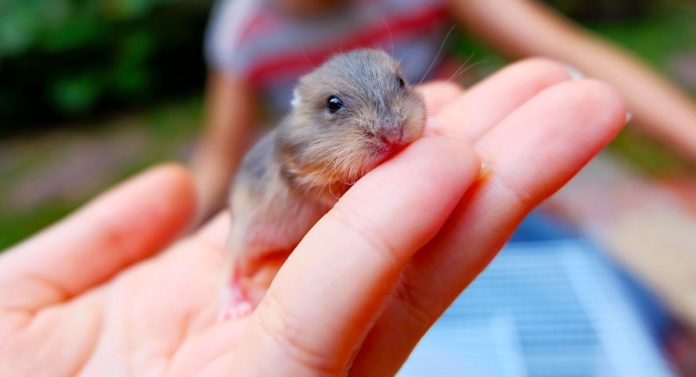
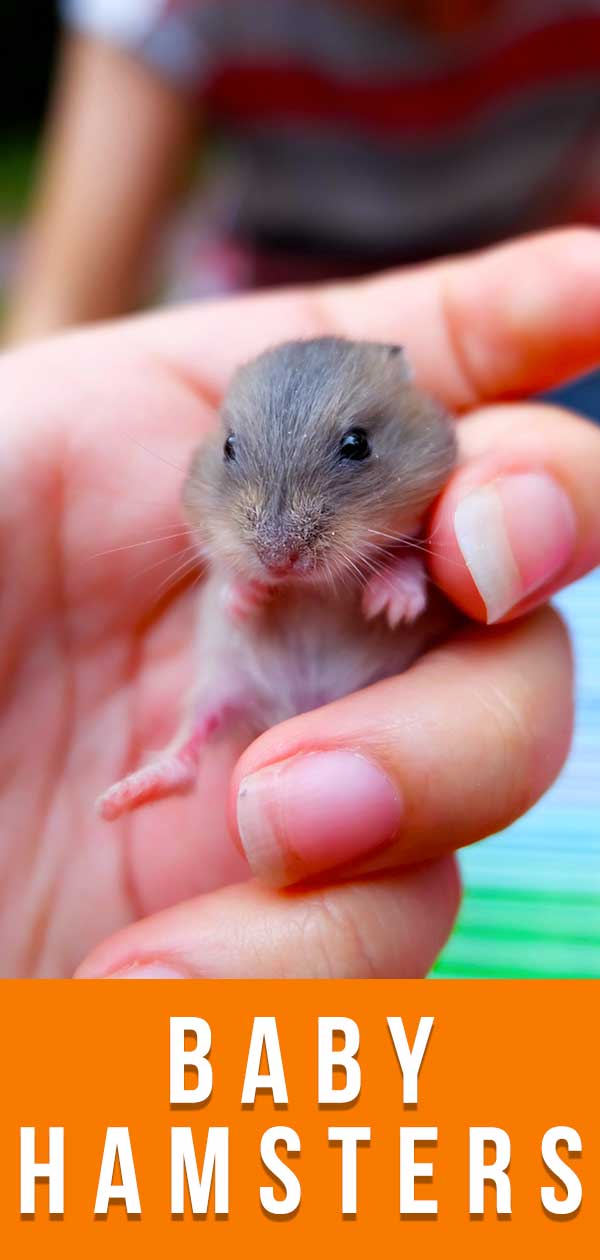
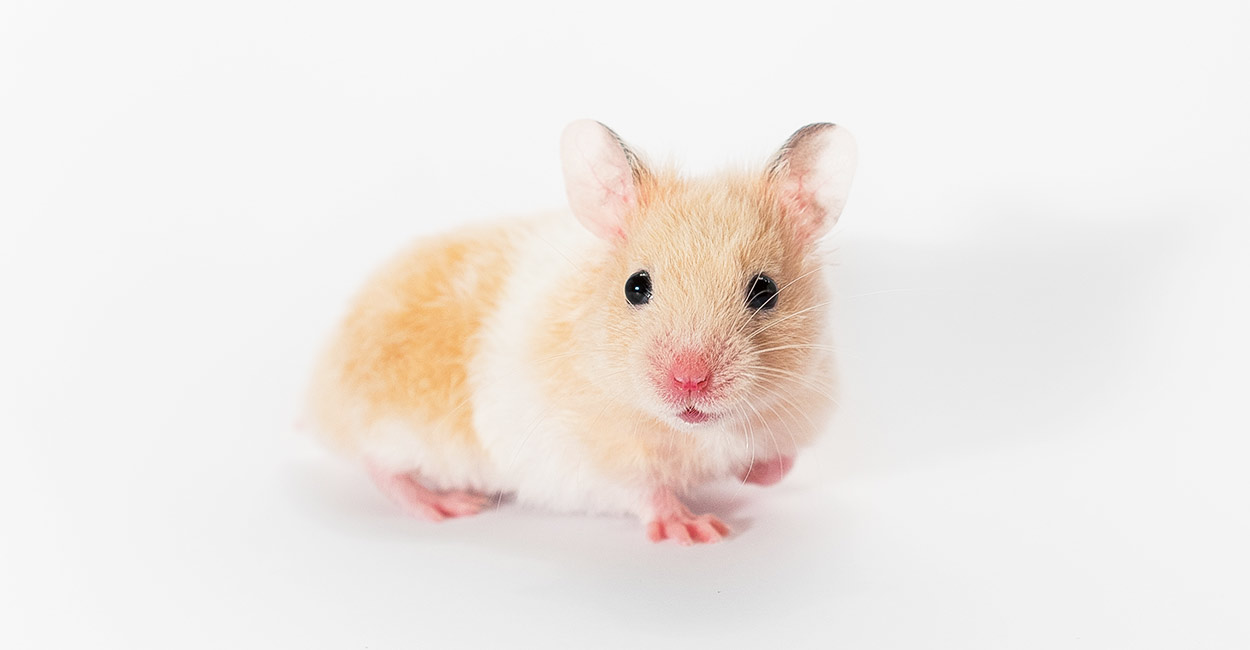
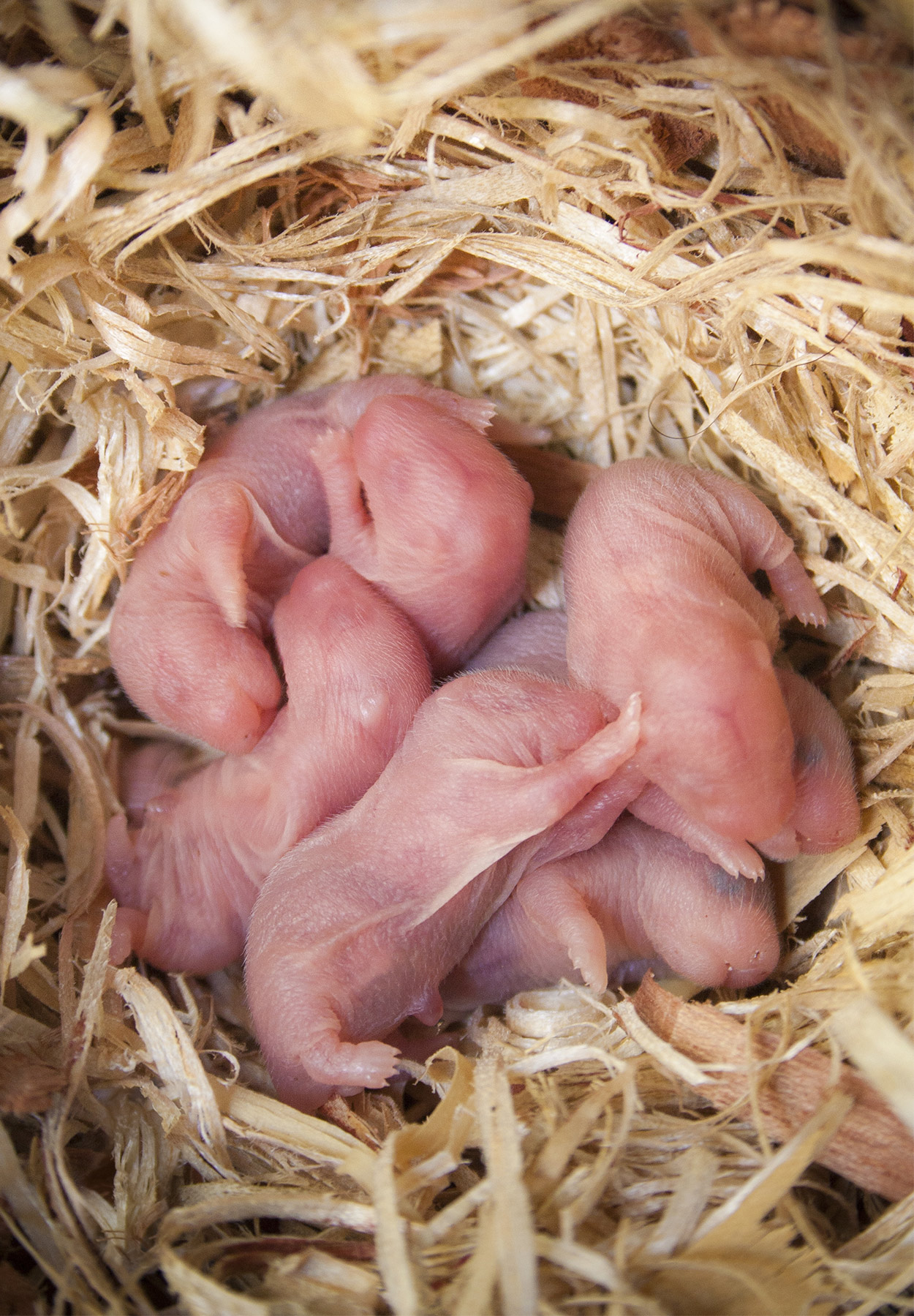
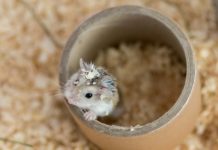

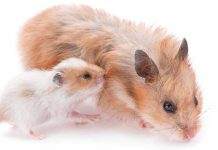











my Syrian just gave birth for the first time and has has 12 pups! I was only expecting 6 or 8 was a bit of a shock but all pups and mum doing well
Hi, so I am a new owner and my teddybear boy got my Oreo colored hamster pregnant. I have never dealt with hamsters before and they were rescues. I am very nervous and honestly scared.
My snoopy gave birth two 6 babies. Today is the 5th day. She is taking care of the babies. We cleaned the cage once, because the food were getting moulds, but didn’t touch the babies.
mine is called appleatechin
My hybrid dwarf’s pups have been extremely active ever since day 1.
By day 2, their skins were already black-ish (the more active pups seemed to have darker skins). Also, I started to notice their really cute whiskers :’
By day 3, their nails were.. longer?
Day 4, their ears were already wide open?? Also, while the mother’s away, one of the pups went far and I found the pup to be sleeping next to the father. However, father left the pup, and the pup started to wander around the cage again. I told the mother to pick the pup up, but she kept asking me to take her outside instead 🙁 I gave her chicken instead 🙁
Day 5, the pups’ skins were already as dark as their mother’s. More pups were exploring the cage. I can hear them crying sometimes. But, since mother doesn’t really bother about picking them up immediately, sometimes, somehow they got to go back to their spot by themselves :/
Day 6 is still tomorrow. Tbh, I’m not sure if they’re going to make it since I kind of disobey every references I’ve read, because I technically can’t get rid of the father (since the mother prefers to rest near the father). The father also sometimes would lick the baby or something I’m not sure. But he wouldn’t stay too long near them, probably since the pup would be looking after his non-existence nipple.
My hamster had 7 pups. Today they are one week old and already growing so much. This is her second time giving birth. The fisrt time I panicked and touched the babies. She had 5 and only 1 survived. I give the babies to my local pet shop. They give me 30 dollars for one and then sel them for 50 dollars.